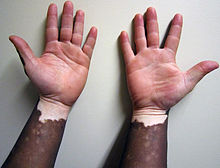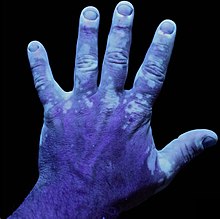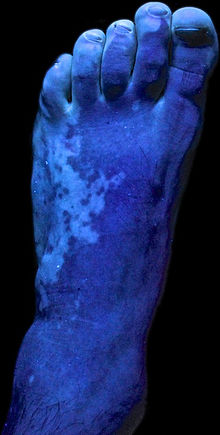This is an old revision of this page, as edited by ACupOfCoffee (talk | contribs) at 01:20, 31 December 2016 (→De-pigmenting: Deleted a paragraph that basically repeats the previous one). The present address (URL) is a permanent link to this revision, which may differ significantly from the current revision.
Revision as of 01:20, 31 December 2016 by ACupOfCoffee (talk | contribs) (→De-pigmenting: Deleted a paragraph that basically repeats the previous one)(diff) ← Previous revision | Latest revision (diff) | Newer revision → (diff) For the Krizz Kaliko album, see Vitiligo (album).Medical condition
| Vitiligo | |
|---|---|
| Specialty | Dermatology |
Vitiligo is a long term skin condition characterized by patches of the skin losing their pigment. The patches of skin affected become white and usually have sharp margins. The hair from the skin may also become white. Inside the mouth and nose may also be involved. Typically both sides of the body are affected. Often the patches begin on areas of skin that are exposed to the sun. It is more noticeable in people with dark skin. Vitiligo may result in psychological stress and those affected may be stigmatized.
The cause is typically unknown. It is believed to be due to genetic susceptibility that is triggered by an environmental factor such that an autoimmune disease occurs. This results in the destruction of skin pigment cells. Risk factors include a family history of the condition or other autoimmune diseases, such as hyperthyroidism, alopecia areata, and pernicious anemia. Vitiligo is classified into two main types: segmental and non-segmental. Most cases are non-segmental meaning they affect both sides and typically get worse with time. About 10% of cases are segmental meaning they mostly involve one side of the body and do not typically worsen with time. Diagnosis can be confirmed by tissue biopsy.
There is no known cure for vitiligo. For those with light skin, sunscreen and makeup are all that is typically recommended. Other treatment options may include steroid creams or phototherapy to darken the light patches. Alternatively, efforts to lighten the unaffected skin, such as with hydroquinone, may be tried. A number of surgical options are available for those who do not improve with other measures. A combination of treatments generally has better outcomes. Counselling to provide emotional support may be useful.
Globally about 1% of people are affected by vitiligo. Some populations have rates as high as 2–3%. Males and females are equally affected. About half show the disorder before age 20 and most develop it before age 40. Vitiligo has been described since ancient history.
Classification
Classification attempts to quantify vitiligo have been analyzed as being somewhat inconsistent, while recent consensus have agreed to a system of segmental vitiligo (SV) and non-segmental vitiligo (NSV). NSV is the most common type of vitiligo.
Non-segmental
In non-segmental vitiligo (NSV), there is usually some form of symmetry in the location of the patches of depigmentation. New patches also appear over time and can be generalized over large portions of the body or localized to a particular area. Extreme cases of vitiligo, to the extent that little pigmented skin remains, are referred to as vitiligo universalis. NSV can come about at any age (unlike segmental vitiligo, which is far more prevalent in teenage years).
Classes of non-segmental vitiligo include the following:
- Generalized Vitiligo: the most common pattern, wide and randomly distributed areas of depigmentation
- Universal Vitiligo: depigmentation encompasses most of the body
- Focal Vitiligo: one or a few scattered macules in one area, most common in children
- Acrofacial Vitiligo: fingers and periorificial areas
- Mucosal Vitiligo: depigmentation of only the mucous membranes
Segmental
Segmental vitiligo (SV) differs in appearance, cause and prevalence of associated illnesses. Its treatment is different from that of NSV. It tends to affect areas of skin that are associated with dorsal roots from the spinal cord and is most often unilateral. It is much more stable/static in course and its association with autoimmune diseases appears to be weaker than that of generalized vitiligo. SV does not improve with topical therapies or UV light, however surgical treatments such as cellular grafting can be effective.
Signs and symptoms


The only sign of vitiligo is the presence of pale patchy areas of depigmented skin which tend to occur on the extremities. The patches are initially small, but often grow and change shape. When skin lesions occur, they are most prominent on the face, hands and wrists. The loss of skin pigmentation is particularly noticeable around body orifices, such as the mouth, eyes, nostrils, genitalia and umbilicus. Some lesions have increased skin pigment around the edges. Patients who are stigmatized for their condition may experience depression and similar mood disorders.
Causes
Although multiple hypotheses have been suggested as potential triggers that cause vitiligo, studies strongly imply that changes in the immune system are responsible for the condition. Vitiligo has been proposed to be a multifactorial disease with genetic susceptibility and environmental factors both thought to play a role.
The TYR gene encodes the protein tyrosinase, which is not a component of the immune system, but is an enzyme of the melanocyte that catalyzes melanin biosynthesis, and a major autoantigen in generalized vitiligo. Some state that sunburns can cause the disease but there is not good evidence to support this.
Immune
Variations in genes that are part of the immune system or part of melanocytes have both been associated with vitiligo. It is also thought to be caused by the immune system attacking and destroying the melanocytes of the skin. A genomewide association study found approximately 36 independent susceptibility loci for generalized vitiligo.
Autoimmune associations
Vitiligo is sometimes associated with autoimmune and inflammatory diseases such as Hashimoto's thyroiditis, scleroderma, rheumatoid arthritis, type 1 diabetes mellitus, psoriasis, Addison's disease, pernicious anemia, alopecia areata, and systemic lupus erythematosus.
Among the inflammatory products of NALP1 are caspase 1 and caspase 7, which activate the inflammatory cytokine interleukin-1β. Interleukin-1β is expressed at high levels in patients with vitiligo. In one of the mutations, the amino acid leucine in the NALP1 protein was replaced by histidine (Leu155->His). The original protein and sequence is highly conserved in evolution, and is found in humans, chimpanzee, rhesus monkey, and the bush baby. Addison's disease (typically an autoimmune destruction of the adrenal glands) may also be seen in individuals with vitiligo.
Diagnosis


An ultraviolet light can be used in the early phase of this disease for identification and to determine the effectiveness of treatment. Skin with vitiligo, when exposed to a blacklight, will glow blue. In contrast, healthy skin will have no reaction.
Differential diagnosis
Conditions with similar symptoms include the following:
- Pityriasis alba
- Tuberculoid leprosy
- Postinflammatory hypopigmentation
- Tinea versicolor
- Albinism
- Piebaldism
- Idiopathic guttate hypomelanosis
- Progressive macular hypomelanosis
- Primary adrenal insufficiency
Treatment
There is no cure for vitiligo but several treatment options are available. The best evidence is for applied steroids and the combination of ultraviolet light in combination with creams. Due to the higher risks of skin cancer, the United Kingdom's National Health Service suggests phototherapy only be used if primary treatments are ineffective. Lesions located on the hands, feet, and joints are the most difficult to repigment; those on the face are easiest to return to the natural skin color.
Immune mediators
Topical preparations of immune suppressing medications including glucocorticoids (such as 0.05% clobetasol or 0.10% betamethasone) and calcineurin inhibitors (such as tacrolimus or pimecrolimus) are considered to be first-line vitiligo treatments.
Phototherapy
Phototherapy is considered a second-line treatment for vitiligo. Exposing the skin to light from UVB lamps is the most common treatment for vitiligo. The treatments can be done at home with an UVB lamp or in a clinic. The exposure time is managed so that the skin does not suffer overexposure. Treatment can take a few weeks if the spots are on the neck and face and if they existed not more than 3 years. If the spots are on the hands and legs and have been there more than 3 years, it can take a few months. Phototherapy sessions are done 2–3 times a week. Spots on a large area of the body may require full body treatment in a clinic or hospital. UVB broadband and narrowband lamps can be used, but narrowband ultraviolet picked around 311 nm is the choice. It has been constitutively reported that combination of UVB phototherapy with other topical treatments improves repigmentation.
Ultraviolet light (UVA) treatments are normally carried out in a hospital clinic. Psoralen and ultraviolet A light (PUVA) treatment involves taking a drug that increases the skin's sensitivity to ultraviolet light, then exposing the skin to high doses of UVA light. Treatment is required twice a week for 6–12 months or longer. Because of the high doses of UVA and psoralen, PUVA may cause side effects such as sunburn-type reactions or skin freckling.
Narrowband ultraviolet B (NBUVB) phototherapy lacks the side-effects caused by psoralens and is as effective as PUVA. As with PUVA, treatment is carried out twice weekly in a clinic or every day at home, and there is no need to use psoralen.
Skin camouflage
In mild cases, vitiligo patches can be hidden with makeup or other cosmetic camouflage solutions. If the affected person is pale-skinned, the patches can be made less visible by avoiding tanning of unaffected skin.
De-pigmenting
In cases of extensive vitiligo the option to de-pigment the unaffected skin with topical drugs like monobenzone, mequinol, or hydroquinone may be considered to render the skin an even colour. The removal of all the skin pigment with monobenzone is permanent and vigorous. Sun-safety must be adhered to for life to avoid severe sun burn and melanomas. Depigmentation takes about a year to complete.
History
Descriptions of a disease believed to be vitiligo date back to a passage in the medical text Ebers Papyrus circa 1500 BC in ancient Egypt. Mentions of whitening of the skin was also present circa 1400 BC in sacred Indian texts such as Atharvaveda as well as Shinto prayers in East Asia circa 1200 BC. The Hebrew word "Zora'at" from the Old Testament book of Leviticus dating to 1280 BCE (or 1312 BCE) described a group of skin disease associated with white spots, and a subsequent translation to Greek led to continued conflation of those with vitiligo with leprosy and spiritual uncleanliness. Medical sources in the ancient world such as Hippocrates often did not differentiate between vitiligo and leprosy, often grouping these diseases together. In Arabic literature, the word "alabras" has been associated with vitiligo, with this word found in the Quran. The name "vitiligo" was first used by the Roman physician Aulus Cornelius Celsus in his classic medical text De Medicina.
Etymology
The etymology of the term "vitiligo" is believed to be derived from "vitium", meaning "defect" or "blemish".
Notable cases

- Pop music singer Michael Jackson revealed in an interview with Oprah Winfrey in February 1993 that he had vitiligo. This was confirmed by the autopsy report following his death in 2009.
- Canadian model Chantelle Brown-Young (known by her stage name Winnie Harlow) has a prominent form of vitiligo. Her participation in the America's Next Top Model contest led to her being called a "vitiligo spokesmodel".
- P. Sathasivam, who is the current Governor of Kerala, in office since 2014, has vitiligo. He previously served as the 40th Chief Justice of India from 2013 to 2014.
- Former WBC Interim Middleweight Boxing Champion Marco Antonio Rubio has vitiligo.
- NFL assistant coach Karl Dunbar was diagnosed with the condition in the 7th grade.
- Michaela DePrince, a Sierra Leonean American ballet dancer, is the only dancer of African origin in the Dutch National Ballet, lived in a refugee camp as a child and was called "devil's child" because of vitiligo.
- Bryan Lloyd Danielson, an American retired professional wrestler best known for his tenure in WWE under the name Daniel Bryan, stated on Twitter that he has vitiligo.
- Scott Jorgensen, an American mixed martial arts fighter, has publicly demonstrated all the stages of vitiligo from beginning to end.
Research
Afamelanotide is in phase II and III clinical trials for vitiligo and other skin diseases.
A medication for rheumatoid arthritis, tofacitinib, has been tested for the treatment of vitiligo.
In October 1992, a scientific report was published of successfully transplanting melanocytes to vitiligo affected areas, effectively re- pigmenting the region. The procedure involved taking a thin layer of pigmented skin from the patient's gluteal region. Melanocytes were then separated out to a cellular suspension that was expanded in culture. The area to be treated was then denuded with a dermabrader and the melanocytes graft applied. Between 70 and 85 percent of patients experienced nearly complete repigmentation of their skin. The longevity of the repigmentation differed from person to person. By now, several transplantation techniques have been developed, including transplantation of melanocyte precursors derived from hair follicles. Transplantation procedures are frequently used to treat segmental vitiligo which is poorly responsive to other types of treatment. In non-segmental vitiligo, success is achieved when treating patches that are not expanding (so called stable vitiligo).
See also
3References
- ^ Ezzedine, K; Eleftheriadou, V; Whitton, M; van Geel, N (4 July 2015). "Vitiligo". Lancet (London, England). 386 (9988): 74–84. doi:10.1016/s0140-6736(14)60763-7. PMID 25596811.
- ^ "Questions and Answers about Vitiligo". NIAMS. June 2014. Retrieved 11 August 2016.
- ^ Whitton, M; Pinart, M; Batchelor, JM; et al. (May 2016). "Evidence-based management of vitiligo: summary of a Cochrane systematic review". The British journal of dermatology. 174 (5): 962–9. doi:10.1111/bjd.14356. PMID 26686510.
- "A review of the worldwide prevalence of vitiligo in children/adolescents and adults". Int J Dermatol. 51 (10): 1206–12. October 2012. doi:10.1111/j.1365-4632.2011.05377.x. PMID 22458952.
{{cite journal}}: Unknown parameter|authors=ignored (help) - Picardo, Mauro; Taïeb, Alain, eds. (2009). "Introduction". Vitiligo. Berlin: Springer. ISBN 978-3-540-69360-4.
- ^ Huggins RH, Schwartz RA, Janniger CK (2005). "Vitiligo" (PDF). Acta Dermatovenerologica Alpina, Pannonica et Adriatica. 14 (4): 137–42, 144–5. PMID 16435042.
- ^ Halder, R. M.; et al. (2007). "Vitiligo". In Wolff, K.; et al. (eds.). Fitzpatrick's Dermatology in General Medicine (7th ed.). New York: McGraw-Hill Professional. ISBN 978-0-07-146690-5.
- ^ van Geel N, Mollet I, Brochez L, Dutré M, De Schepper S, Verhaeghe E, Lambert J, Speeckaert R (February 2012). "New insights in segmental vitiligo: case report and review of theories". British Journal of Dermatology. 166 (2): 240–6. doi:10.1111/j.1365-2133.2011.10650.x. PMID 21936857.
{{cite journal}}: Unknown parameter|displayauthors=ignored (|display-authors=suggested) (help) - ^ National Institute of Arthritis and Musculoskeletal and Skin Diseases (March 2007). "What Is Vitiligo? Fast Facts: An Easy-to-Read Series of Publications for the Public Additional". Retrieved 18 July 2010.
- ^ Halder RM, et al. (2007). "72. Vitiligo". In Wolff K, Freedberg IM, Fitzpatrick TB (eds.). Fitzpatrick's dermatology in general medicine (7th ed.). New York: McGraw-Hill Professional. ISBN 978-0-07-146690-5. OCLC 154751587.
- Halder, RM; Chappell, JL (2009). "Vitiligo update". Seminars in cutaneous medicine and surgery. 28 (2): 86–92. doi:10.1016/j.sder.2009.04.008. PMID 19608058.
- Picardi A, Pasquini P, Cattaruzza MS, Gaetano P, Melchi CF, Baliva G, Camaioni D, Tiago A, Abeni D, Biondi M (2003). "Stressful life events, social support, attachment security and alexithymia in vitiligo. A case-control study". Psychotherapy and Psychosomatics. 72 (3): 150–8. doi:10.1159/000069731. PMID 12707482.
{{cite journal}}: Unknown parameter|displayauthors=ignored (|display-authors=suggested) (help) - Ongenae, Katia; Van Geel, Nanny; Naeyaert, Jean-Marie (April 2003). "Evidence for an Autoimmune Pathogenesis of Vitiligo". Pigment Cell Research. 16 (2): 90–100. doi:10.1034/j.1600-0749.2003.00023.x.
- "Questions and Answers about Vitiligo". June 2014. Retrieved 4 October 2015.
- Staff, Mayo Clinic (15 May 2014). "Vitiligo Causes". Mayoclinic. Retrieved 22 April 2015.
- Spritz, Richard A. (May 2013). "Modern vitiligo genetics sheds new light on an ancient disease". The Journal of Dermatology. 40 (5): 310–318. doi:10.1111/1346-8138.12147.
- Gregersen PK (2007). "Modern genetics, ancient defenses, and potential therapies". The New England Journal of Medicine. 356 (12): 1263–6. doi:10.1056/NEJMe078017. PMID 17377166.
- Jin Y, Mailloux CM, Gowan K, et al. (2007). "NALP1 in vitiligo-associated multiple autoimmune disease". The New England Journal of Medicine. 356 (12): 1216–25. doi:10.1056/NEJMoa061592. PMID 17377159.
- Whitton, ME; Ashcroft, DM; González, U (October 2008). "Therapeutic interventions for vitiligo". Journal of the American Academy of Dermatology. 59 (4): 713–7. doi:10.1016/j.jaad.2008.06.023. PMID 18793940.
- ^ Anon. "Vitiligo -Treatment". Patient UK. NHS. Retrieved 3 June 2013.
- Scherschun, L; Kim, JJ; Lim, HW (2001). "Narrow-band ultraviolet B is a useful and well-tolerated treatment for vitiligo". Journal of the American Academy of Dermatology. 44 (6): 999–1003. doi:10.1067/mjd.2001.114752. PMID 11369913.
- Don, Philip; Iuga, Aurel; Dacko, Anne; Hardick, Kathleen (2006). "Treatment of vitiligo with broadband ultraviolet B and vitamins". International Journal of Dermatology. 45 (1): 63–5. doi:10.1111/j.1365-4632.2005.02447.x. PMID 16426381.
- ^ Gauthier, Yvon; Benzekri, Laila (2009). "Historical Aspects". In Picardo, Mauro; Taïeb, Alain (eds.). Vitiligo (Online-Ausg. ed.). Berlin: Springer. ISBN 978-3-540-69360-4.
- Kurzweil, Arthur (2008). The Torah For Dummies (PDF). For Dummies. p. 11. ISBN 978-0-470-28306-6. Retrieved 19 August 2010.
- History Crash Course #36: Timeline: From Abraham to Destruction of the Temple, by Rabbi Ken Spiro, Aish.com. Retrieved 2010-08-19.
- Duke, Alan (7 May 2013). "Autopsy reveals Michael Jackson's secrets". CNN Entertainment. CNN. Retrieved 7 May 2013.
The autopsy apparently confirmed what Jackson told people who questioned why his skin tone became lighter in the 1980s. Jackson had 'vitiligo, a skin pigmentation disease,' Rogers said. 'So, some areas of the skin appear light and others appear dark.'
- Taylor, Victoria (8 May 2014). "'America's Next Top Model' contestant hasn't let rare skin condition hold her back". New York Daily News. Retrieved 9 May 2014.
- "New Delhi: Justice Sathasivam sworn in as chief justice of India". mangalorean.com. July 19, 2013
- Gonzalez, Edgar (2011). "Can Rubio beat Chavez?". My Boxing Fans.
- "Skin condition hasn't stopped Dunbar".
- "HuffPost Teen's '18 Under 18' Of 2012! (PHOTOS)". Huffington Post. 31 December 2012.
- "Daniel Bryan (July 30, 2011). "Tweet Number 97214858474422272". Twitter". 31 October 2014.
- "Scott Jorgensen Says His Vitiligo Makes His Tattoos Look Even Better | FIGHTLAND". Fightland. Retrieved 17 June 2016.
- Fabrikant J; et al. (July 2013). "A review and update on melanocyte stimulating hormone therapy: afamelanotide". J Drugs Dermatol. 12 (7): 775–9. PMID 23884489.
- "For vitiligo patient, arthritis drug restores skin color".
- Olsson MJ, Juhlin L (1992). "Melanocyte transplantation in vitiligo". Lancet. 340 (8825): 981. doi:10.1016/0140-6736(92)92875-G. PMID 1357390.
- Olsson MJ, Juhlin L (2002). "Long-term follow-up of leucoderma patients treated with transplants of autologous cultured melanocytes, ultrathin epidermal sheets and basal cell layer suspension". The British Journal of Dermatology. 147 (5): 893–904. doi:10.1046/j.1365-2133.2002.04837.x. PMID 12410698.
External links
- Template:DMOZ
- Questions and Answers about Vitiligo - US National Institute of Arthritis and Musculoskeletal and Skin Diseases
| Diseases of the skin and appendages by morphology | |||||||||||||||||||||||||||||||||||
|---|---|---|---|---|---|---|---|---|---|---|---|---|---|---|---|---|---|---|---|---|---|---|---|---|---|---|---|---|---|---|---|---|---|---|---|
| Growths |
| ||||||||||||||||||||||||||||||||||
| Rashes |
| ||||||||||||||||||||||||||||||||||
| Miscellaneous disorders |
| ||||||||||||||||||||||||||||||||||
| Pigmentation disorders/Dyschromia | |||||||||||||||||||||
|---|---|---|---|---|---|---|---|---|---|---|---|---|---|---|---|---|---|---|---|---|---|
| Hypo-/ leucism |
| ||||||||||||||||||||
| Hyper- |
| ||||||||||||||||||||
| Dyschromia | |||||||||||||||||||||
| See also | |||||||||||||||||||||